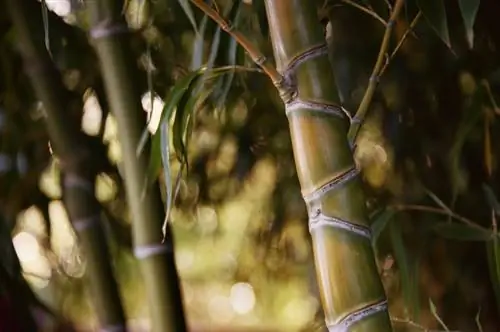- Author admin [email protected].
- Public 2023-12-16 16:46.
- Last modified 2025-01-23 11:21.
The lilac, which blooms so wonderfully lush and fragrant in spring, is a neophyte. Experts understand this as non-native plant species that are spreading rapidly. Syringa, the Latin name for the lilac, spreads very quickly via root runners, which develop in large numbers from the roots growing close to the earth's surface. In general, the roots of the shrub are legendary - over the years they form a dense felt that is difficult to penetrate.

How do lilac roots grow and how can I control them?
Lilac roots mainly spread close to the surface of the earth and can colonize neighboring areas with root runners. To control the spread, a root barrier is recommended. When removing the lilac, the roots should also be completely removed to avoid uncontrolled new growth.
How Lilac Roots Grow
The roots of the lilac run mainly close to the surface and over the years spread to a radius of several meters around the main trunk. The older the bush gets, the more matted the numerous fine roots become, so that penetration - for example because the lilac is to be planted under or a neighboring bed is to be cultivated - becomes difficult. However, lilacs are not purely shallow-rooted, because depending on the nature and nutrient content of the soil, some roots can also grow deeper and thus ensure the plant's supply.
Sensible: installing a root barrier
Since numerous root runners grow from the dense network of roots close to the surface and neighboring beds or foundations also have to be protected from invasion, it makes sense to install a root barrier when planting. Barriers developed specifically for bamboo have proven particularly useful for this purpose. However, placing a pond liner in the planting hole or something similar, as is sometimes recommended, is not sufficient. The strong roots of the lilac simply penetrate this material.
Can roots damage foundations?
You don't need to worry: Unless your house is very old and has already been damaged by moisture, the lilac roots have no chance of penetrating. The situation is different with unsealed garden walls, which can be penetrated easily and grow happily over to the neighbor. Here you should definitely install a root barrier and maintain the recommended minimum distance.
Remove lilacs with roots or not?
If you want or have to remove a lilac, you should always remove the root system from the soil as completely as possible. Simply sawing off the trunk is not enough to remove it - as a result, the stressed plant will only produce more runners, meaning that you will have to remove hundreds of mini lilacs within a radius of several meters within a very short space of time.
Removing root runners: How to do it right
You can permanently remove the root runners if you expose their base and tear them out along with the sleeping eyes. On the other hand, if you only cut them off on the surface (for example by simply running a lawnmower over them), the roots will only grow out more, which will result in even more shoots forming. You can also prevent their formation by covering the area in question - if it is at all possible - with mulching material or a weed film.
How to keep root suckers in check
You can reduce the formation of root runners to a minimum if you
- observe the recommended planting distance
- don't cut back the lilac too much
- do not damage the roots by hoeing, digging, a lawn mower or under plants
- or leave the rhizome in the ground after sawing off an old specimen.
Tip
You can also use the root suckers for easy propagation of lilacs.






